.
7.04.2015
Dear Dawnticipating Explorers,
Now orbiting high over the night side of a dwarf planet far from Earth, Dawn arrived at its new permanent residence on March 6. Ceres welcomed the newcomer from Earth with a gentle but firm gravitational embrace. The goddess of agriculture will never release her companion. Indeed, Dawn will only get closer from now on. With the ace flying skills it has demonstrated many times on this ambitious deep-space trek, the interplanetary spaceship is using its ion propulsion system to maneuver into a circular orbit 8,400 miles (13,500 kilometers) above the cratered landscape of ice and rock. Once there, it will commence its first set of intensive observations of the alien world it has traveled for so long and so far to reach.
For now, however, Dawn is not taking pictures. Even after it entered orbit, its momentum carried it to a higher altitude, from which it is now descending. From March 2 to April 9, so much of the ground beneath it is cloaked in darkness that the spacecraft is not even peering at it. Instead, it is steadfastly looking ahead to the rewards of the view it will have when its long, leisurely, elliptical orbit loops far enough around to glimpse the sunlit surface again.
Among the many sights we eagerly anticipate are those captivating bright spots. Hinted at more than a decade ago by Hubble Space Telescope, Dawn started to bring them into sharper focus after an extraordinary journey of more than seven years and three billion miles (nearly five billion kilometers). Although the spots are reflections of sunlight, they seem almost to radiate from Ceres as cosmic beacons, drawing us forth, spellbound. Like interplanetary lighthouses, their brilliant glow illuminates the way for a bold ship from Earth sailing on the celestial seas to a mysterious, uncharted port. The entrancing lights fire our imagination and remind us of the irresistible lure of exploration and the powerful anticipation of an adventure into the unknown.
As we describe below, Dawn’s extensive photographic coverage of the sunlit terrain in early May will include these bright spots. They will not be in view, however, when Dawn spies the thin crescent of Ceres in its next optical navigation session, scheduled for April 10 (as always, all dates here are in the Pacific time zone).
As the table here shows, on April 14 (and extending into April 15), Dawn will obtain its last navigational fix before it finishes maneuvering. Should we look forward to catching sight of the bright spots then? In truth, we do not yet know. The spots surely will be there, but the uncertainty is exactly where “there” is. We still have much to learn about a dwarf planet that, until recently, was little more than a fuzzy patch of light among the glowing jewels of the night sky. (For example, only last month did we determine where Ceres’ north and south poles point.) Astronomers had clocked the length of its day, the time it takes to turn once on its axis, at a few minutes more than nine hours. But the last time the spots were in view of Dawn’s camera was on Feb. 19. From then until April 14, while Earth rotates more than 54 times (at 24 hours per turn), Ceres will rotate more than 140 times, which provides plenty of time for a small discrepancy in the exact rate to build up. To illustrate this, if our knowledge of the length of a Cerean day were off by one minute (or less than 0.2 percent), that would translate into more than a quarter of a turn during this period, drastically shifting the location of the spots from Dawn’s point of view. So we are not certain exactly what range of longitudes will be within view in the scheduled OpNav 7 window. Regardless, the pictures will serve their intended purpose of helping navigators establish the probe’s location in relation to its gravitational captor.
Dawn’s gradual, graceful arc down to its first mapping orbit will take the craft from the night side to the day side over the north pole, and then it will travel south. It will conclude its powered flight over the sunlit terrain at about 60 degrees south latitude. The spacecraft will finish reshaping its orbit on April 23, and when it stops its ion engine on that date, it will be in its new circular orbit, designated RC3. (We will return to the confusing names of the different orbits at Ceres below.) Then it will coast, just as the moon coasts in orbit around Earth and Earth coasts around the sun. It will take Dawn just over 15 days to complete one revolution around Ceres at this height. We had a preview of RC3 last year, and now we can take an updated look at the plans.
.

Dawn’s final swoop down to RC3 orbit. The sun is off the figure far to the left, and Ceres’ north pole points up. The farther Dawn is to the right side of Ceres here, the smaller a crescent it sees, because the illumination is from the left. The white circles are at one-day intervals. The trajectory is solid where Dawn is thrusting with its ion engine, which is most of the time. The labels show four optical navigation sessions, where it pauses to turn, point at Ceres, conduct the indicated observation, turn to point its main antenna to Earth, transmit its findings, turn back to the orientation needed for thrusting, and then restart the ion engine. Dawn was captured into orbit on March 6. Note the periods on the right side of the figure between OpNav 5 (on March 1) and OpNav 6 (on April 10) when Dawn pauses thrusting for telecommunications and radio navigation but does not take pictures because it would have to point its instruments too close to the sun. Apodemeter is the Dawn team’s word for the highest altitude in orbit, in analogy with the more common term apogee, which applies for Earth orbits. (Demeter is the Greek counterpart of the Roman goddess Ceres.) Dawn was at its apodemeter of 46,800 miles (75,400 kilometers) on March 18. For more on Dawn’s approach trajectory, see the overall description and figures from other perspectives in November (including the motion into and out of this flat depiction), further details (including the OpNavs) in February and an animation in March. Credit: NASA/JPL
.
The dwarf planet is around 590 miles (950 kilometers) in diameter (like Earth and other planets, however, it is slightly wider at the equator than from pole to pole). At the spacecraft’s orbital altitude, it will appear to be the same size as a soccer ball seen from 10 feet (3 meters) away. Part of the basis upon which mission planners chose this distance for the first mapping campaign is that the visible disc of Ceres will just fit in the camera’s field of view. All the pictures taken at lower altitudes will cover a smaller area (but will be correspondingly more detailed). The photos from RC3 will be 3.4 times sharper than those in RC2.
There will be work to do before photography begins however. The first order of business after concluding ion thrusting will be for the flight team to perform a quick navigational update (this time, using only the radio signal) and transmit any refinements (if necessary) in Dawn’s orbital parameters, so it always has an accurate knowledge of where it is. (These will not be adjustments to the orbit but rather a precise mathematical description of the orbit it achieved.) Controllers will also reconfigure the spacecraft for its intensive observations, which will commence on April 24 as it passes over the south pole and to the night side again.
As at Vesta, even though half of each circular orbit will be over the night side of Ceres, the spacecraft itself will never enter the shadows. The operations team has carefully designed the orbits so that at Dawn’s altitude, it remains illuminated by the sun, even when the land below is not.
It may seem surprising (or even be surprising) that Dawn will conduct measurements when the ground directly beneath it is hidden in the deep darkness of night. To add to the surprise, these observations were not even envisioned when Dawn’s mission was designed, and it did not perform comparable measurements during its extensive exploration of Vesta in 2011-2012.
The measurements on the night side will serve several purposes. One of the many sophisticated techniques scientists use to elucidate the nature of planetary surfaces is to measure how much light they reflect at different angles. Over the course of the next year, Dawn will acquire tens of thousands of pictures from the day side of Ceres, when, in essence, the sun is behind the camera. When it is over the night side in RC3, carefully designed observations of the lit terrain (with the sun somewhat in front of the camera, although still at a safe angle) will significantly extend the range of angles.
In December, we described the fascinating discovery of an extremely diffuse veil of water vapor around Ceres. How the water makes its way from the dwarf planet high into space is not known. The Dawn team has devised a plan to investigate this further, even though the tiny amount of vapor was sighted long after the explorer left Earth equipped with sensors designed to study worlds without atmospheres.
It is worth emphasizing that the water vapor is exceedingly tenuous. Indeed, it is much less dense than Earth’s atmosphere at altitudes above the International Space Station, which orbits in what most people consider to be the vacuum of space. Our hero will not need to deploy its umbrella. Even comets, which are miniscule in comparison with Ceres, liberate significantly more water.
There may not even be any water vapor at all now because Ceres is farther from the sun than when the Herschel Space Observatory saw it, but if there is, detecting it will be very challenging. The best method to glimpse it is to look for its subtle effects on light passing through it. Although Dawn cannot gaze directly at the sun, it can look above the lit horizon from the night side, searching intently for faint signs of sunlight scattered by sparse water molecules (or perhaps dust lofted into space with them).
For three days in RC3 after passing over the south pole, the probe will take many pictures and visible and infrared spectra as it watches the slowly shrinking illuminated crescent and the space over it. When the spacecraft has flown to about 29 degrees south latitude over the night side, it will no longer be safe to aim its sensitive instruments in that direction, because they would be too close to the sun. With its memory full of data, Dawn will turn to point its main antenna toward distant Earth. It will take almost two days to radio its findings to NASA’s Deep Space Network. Meanwhile, the spacecraft will continue northward, gliding silently high over the dark surface.
On April 28, it will rotate again to aim its sensors at Ceres and the space above it, resuming measurements when it is about 21 degrees north of the equator and continuing almost to the north pole on May 1. By the time it turns once again to beam its data to Earth, it will have completed a wealth of measurements not even considered when the mission was being designed.
Loyal readers will recall that Dawn has lost two of its four reaction wheels, gyroscope-like devices it uses to turn and to stabilize itself. Although such a loss could be grave for some missions, the operations team overcame this very serious challenge. They now have detailed plans to accomplish all of the original Ceres objectives regardless of the condition of the reaction wheels, even the two that have not failed (yet). It is quite a testament to their creativity and resourcefulness that despite the tight constraints of flying the spacecraft differently, the team has been able to add bonus objectives to the mission.
.
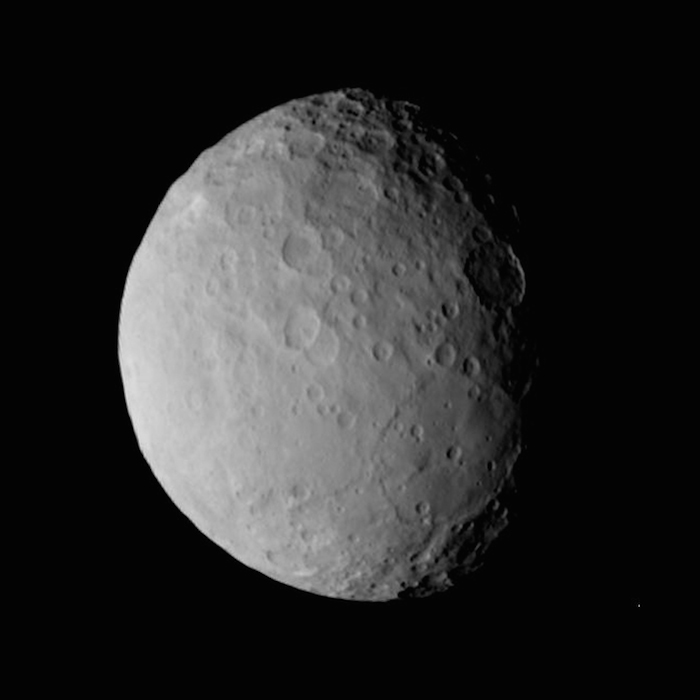
Dawn had this view of Ceres on Feb. 19 at a distance of 28,000 miles (46,000 kilometers). Among the puzzling features is the large structure below and to the right of center. Pictures in RC3 will be more than three times sharper. Credit: NASA/JPL-Caltech/UCLA/MPS/DLR/IDA
.
Dawn will finish transmitting its data after its orbit takes it over the north pole and to the day side of Ceres again. For three periods during its gradual flight of more than a week over the illuminated landscape, it will take pictures (in visible and near-infrared wavelengths) and spectra. Each time, it will look down from space for a full Cerean day, watching for more than nine hours as the dwarf planet pirouettes, as if showing off to her new admirer. As the exotic features parade by, Dawn will faithfully record the sites.
It is important to set the camera exposures carefully. Most of the surface reflects nine percent of the sunlight. (For comparison, the moon reflects 12 percent on average, although as many Earthlings have noticed, there is some variation from place to place. Mars reflects 17 percent, and Vesta reflects 42 percent. Many photos seem to show that your correspondent’s forehead reflects about 100 percent.) But there are some small areas that are significantly more reflective, including the two most famous bright spots. Each spot occupies only one pixel (2.7 miles, or 4.3 kilometers across) in the best pictures so far. If each bright area on the ground is the size of a pixel, then they reflect around 40 percent of the light, providing the stark contrast with the much darker surroundings. When Dawn’s pictures show more detail, it could be that they will turn out to be even smaller and even more reflective than they have appeared so far. In RC3, each pixel will cover 0.8 miles (1.3 kilometers). To ensure the best photographic results, controllers are modifying the elaborate instructions for the camera to take pictures of the entire surface with a wider range of exposures than previously planned, providing high confidence that all dark and all bright areas will be revealed clearly.
Dawn will observe Ceres as it flies from 45 degrees to 35 degrees north latitude on May 3-4. Of course, the camera’s view will extend well north and south of the point immediately below it. (Imagine looking at a globe. Even though you are directly over one point, you can see a larger area.) The territory it will inspect will include those intriguing bright spots. The explorer will report back to Earth on May 4-5. It will perform the same observations between 5 degrees north and 5 degrees south on May 5-6 and transmit those findings on May 6-7. To complete its first global map, it will make another full set of measurements for a Cerean day as it glides between 35 degrees and 45 degrees south on May 7.
By the time it has transmitted its final measurements on May 8, the bounty from RC3 may be more than 2,500 pictures and two million spectra. Mission controllers recognize that glitches are always possible, especially in such complex activities, and they take that into account in their plans. Even if some of the scheduled pictures or spectra are not acquired, RC3 should provide an excellent new perspective on the alien world, displaying details three times smaller than what we have discerned so far.
Dawn activated its gamma ray spectrometer and neutron spectrometer on March 12, but it will not detect radiation from Ceres at this high altitude. For now, it is measuring space radiation to provide context for later measurements. Perhaps it will sense some neutrons in the third mapping orbit this summer, but its primary work to determine the atomic constituents of the material within about a yard (meter) of the surface will be in the lowest altitude orbit at the end of the year.
.
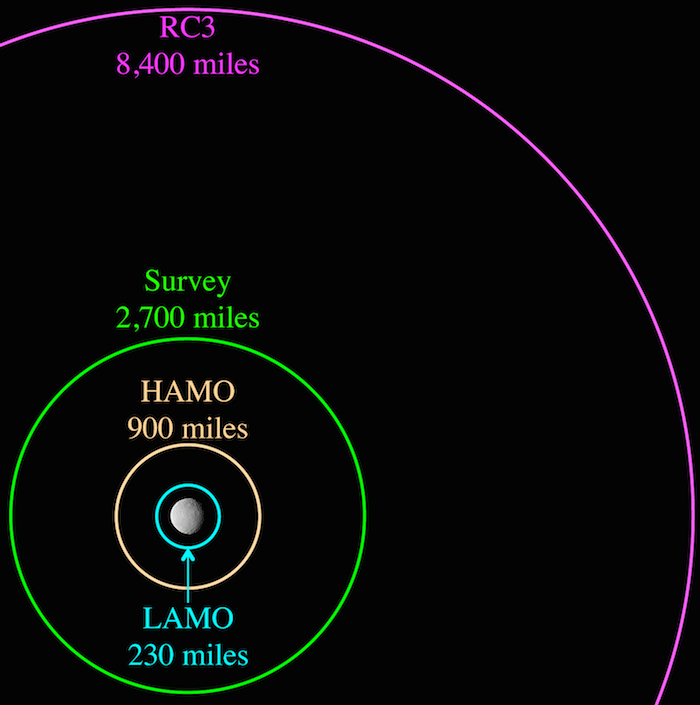
Dawn’s four mapping orbits, shown to scale in altitude with the size of Ceres, which is about 590 miles (950 kilometers) in diameter. (Note: colors of the orbits here are only approximate.) The table below includes links to descriptions of the activities in each orbit. Credit: NASA/JPL
.
Dawn will conduct its studies from three lower orbital altitudes after RC3, taking advantage of the tremendous maneuverability provided by ion propulsion to spiral from one to another. We presented previews last year of each phase, and as each approaches, we will give still more up-to-date details, but now that Dawn is in orbit, let’s summarize them here. Of course, with complicated operations in the forbidding depths of space, there are always possibilities for changes, especially in the schedule. The team has developed an intricate but robust and flexible plan to extract as many secrets from Ceres as possible, and they will take any changes in stride.
Each orbit is designed to provide a better view than the one before, and Dawn will map the orb thoroughly while at each altitude. The names for the orbits – rotation characterization 3 (RC3); survey; high altitude mapping orbit (HAMO); and low altitude mapping orbit (LAMO) – are based on ancient ideas, and the origins are (or should be) lost in the mists of time. Readers should avoid trying to infer anything at all meaningful in the designations. After some careful consideration, your correspondent chose to use the same names the Dawn team uses rather than create more helpful descriptors for the purposes of these blogs. That ensures consistency with other Dawn project communications. After all, what is important is not what the different orbits are called but rather what amazing new discoveries each one enables.
The robotic explorer will make many kinds of measurements with its suite of powerful instruments. As one indication of the improving view, this table includes the resolution of the photos, and the ever finer detail may be compared with the pictures during the approach phase. For another perspective, we extend the soccer ball analogy above to illustrate how large Ceres will appear to be from the spacecraft’s orbital vantage point.
.
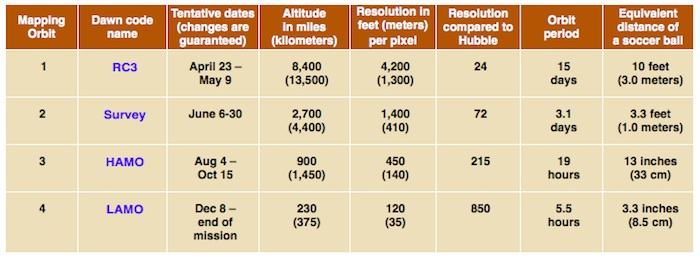
As Dawn orbits Ceres, together they orbit the sun. Closer to the master of the solar system, Earth (with its own retinue, including the moon and many artificial satellites) travels faster in its heliocentric orbit because of the sun’s stronger gravitational pull at its location. In December, Earth was on the opposite side of the sun from Dawn, and now the planet’s higher speed is causing their separation to shrink. Earth will get closer and closer until July 22, when it will pass on the inside track, and the distance will increase again.
In the meantime, on April 12, Dawn will be equidistant from the sun and Earth. The spacecraft will be 2.89 AU or 269 million miles (433 million kilometers) from both. At the same time, Earth will be 1.00 AU or 93.2 million miles (150 million kilometers) from the sun.
.
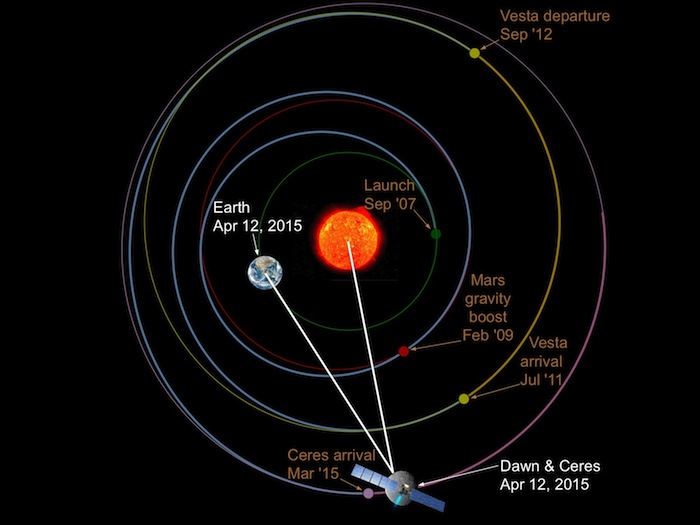
Illustration of the relative locations (but not sizes) of Earth, the sun, Dawn and Ceres on April 12, 2015. (Earth and the sun are at that location every April 12.) The distance from Earth to Dawn is the same as the distance from the sun to Dawn. The images are superimposed on the trajectory for the entire mission, showing the positions of Earth, Mars, Vesta, and Ceres at milestones during Dawn’s voyage. Compare this to the arrangement in December, when Earth and Dawn were on opposite sides of the sun. Credit: NASA/JPL
.
It will be as if Dawn is at the tip of a giant celestial arrowhead, pointing the way to a remarkable solar system spectacle. The cosmos should take note! Right there, a sophisticated spaceship from Earth is gracefully descending on a blue-green beam of xenon ions. Finally, the dwarf planet beneath it, a remote remnant from the dawn of the solar system, is lonely no more. Almost 4.6 billion years after it formed, and 214 years after inquisitive creatures on a distant planet first caught sight of it, a mysterious world is still welcoming the new arrival. And as Dawn prepares to settle into its first close orbit, ready to discover secrets Ceres has kept for so long, everyone who shares in the thrill of this grand and noble adventure eagerly awaits its findings. Together, we look forward to the excitement of new knowledge, new insight and new fuel for our passionate drive to explore the universe.
Dawn is 35,000 miles (57,000 kilometers) from Ceres, or 15 percent of the average distance between Earth and the moon. It is also 3.04 AU (282 million miles, or 454 million kilometers) from Earth, or 1,120 times as far as the moon and 3.04 times as far as the sun today. Radio signals, traveling at the universal limit of the speed of light, take 51 minutes to make the round trip.
Dr. Marc D. Rayman
Quelle: NASA
.
Update: 16.04.2015
.
Vielfalt der Farben auf Ceres
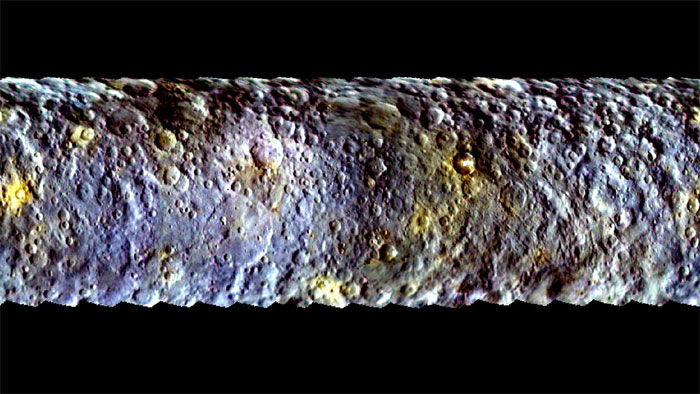
Es ist ein kleiner Kunstgriff, mit dem die Planetenforscher den dunklen Zwergplaneten Ceres farbig machen: Mit sieben Farbfiltern des Kamerasystems an Bord der Raumsonde Dawn analysieren sie in verschiedenen Wellenlängenbereichen, wie Ceres das Licht reflektiert. Die Daten stammen dabei aus der Anflugphase, als Dawn sich dem Zwergplaneten näherte, um am 6. März 2015 in die Umlaufbahn von Ceres einzuschwenken. Die Falschfarbenaufnahmen zeigen dabei deutlich, dass Ceres eine Oberfläche aus verschiedenen Materialien hat. "Ceres offenbart immer mehr, dass wir einen spannenden und vielfältigen Himmelskörper untersuchen", sagt Prof. Ralf Jaumann, Planetenforscher am Deutschen Zentrum für Luft- und Raumfahrt (DLR) und Mitglied im Kamerateam der Dawn-Mission. Die Falschfarbenaufnahmen erstellt das Max-Planck-Institut für Sonnensystemforschung. Das DLR-Institut für Planetenforschung wird den Zwergplaneten kartieren und aus tausenden von Einzelaufnahmen dreidimensionale Geländemodelle berechnen.
Bereits die bisherigen Aufnahmen haben gezeigt, dass Ceres von Kratern übersät ist. Selbst Krater von bis zu 300 Kilometern Durchmesser bedecken den Himmelskörper, der 2006 von der Klasse der Asteroiden in die neue Klasse der Zwergplaneten eingeordnet wurde. Fast 1000 Kilometer beträgt sein Durchmesser - damit gehört er zu den größten Objekten im Asteroidengürtel zwischen Jupiter und Mars. Auffällig waren auf den Bildern der Kamera vor allem mehrere helle Punkte in der nördlichen Hemisphäre. Der hellste Fleck befindet sich sehr wahrscheinlich in einem Krater von 92 Kilometern Durchmesser. Auf was die Wissenschaftler dort blicken, wird sich erst untersuchen lassen, wenn Dawn in ihrem Orbit näher um Ceres kreist.
Umrundung nach Umrundung dichter an Ceres heran
Nach der Ankunft am Zwergplaneten verschwand Dawn zunächst hinter der sonnenabgewandten Seite von Ceres und konnte keine weiteren Bilder aufnehmen. Am 10. April 2015 "tauchte" sie wieder auf und schraubt sich nun bei seinen Umrundungen aus einer Entfernung von 42000 Kilometern bis zum 23. April 2015 auf eine Höhe von nur noch 13500 Kilometern hinunter. Dann beginnt die erste wissenschaftliche Phase: "Dann werden wir auch vielleicht schon die ersten Antworten auf unsere Fragen bekommen", sagt DLR-Planetenforscher Prof. Ralf Jaumann.
Mit Dawn fliegen die Planetenforscher direkt in die Vergangenheit unseres Sonnensystems. Damals, als sich vor 4,5 Milliarden Jahren die Planeten bildeten, sorgten Jupiters Kräfte dafür, dass die Asteroiden in diesem Prozess steckenblieben. Als "halbfertige" Planeten konservieren sie so die Anfänge unseres Sonnensystems und erlauben den Blick in dessen Entstehungszeit. Von 2011 bis 2012 besuchte die Dawn-Sonde der NASA bereits den Asteroiden Vesta, ein wasserarmer Asteroid. Mit Ceres, die hinter der Frostgrenze liegt und dementsprechend eisig ist, untersuchen die Wissenschaftler eine ausgesprochen wasserreichen Himmelskörper: Die Forscher vermuten unter seiner Kruste sogar einen Ozean.
Die Mission
Die Mission DAWN wird vom Jet Propulsion Laboratory (JPL) der amerikanischen Weltraumbehörde NASA geleitet. JPL ist eine Abteilung des California Institute of Technology in Pasadena. Die University of California in Los Angeles ist für den wissenschaftlichen Teil der Mission verantwortlich. Das Kamerasystem an Bord der Raumsonde wurde unter Leitung des Max-Planck-Instituts für Sonnensystemforschung in Göttingen in Zusammenarbeit mit dem Institut für Planetenforschung des Deutschen Zentrums für Luft- und Raumfahrt (DLR) in Berlin und dem Institut für Datentechnik und Kommunikationsnetze in Braunschweig entwickelt und gebaut. Das Kamera-Projekt wird finanziell von der Max-Planck-Gesellschaft, dem DLR und NASA/JPL unterstützt.
Quelle: DLR
.
Update: 17.04.2015
.
Dawn Glimpses Ceres' North Pole
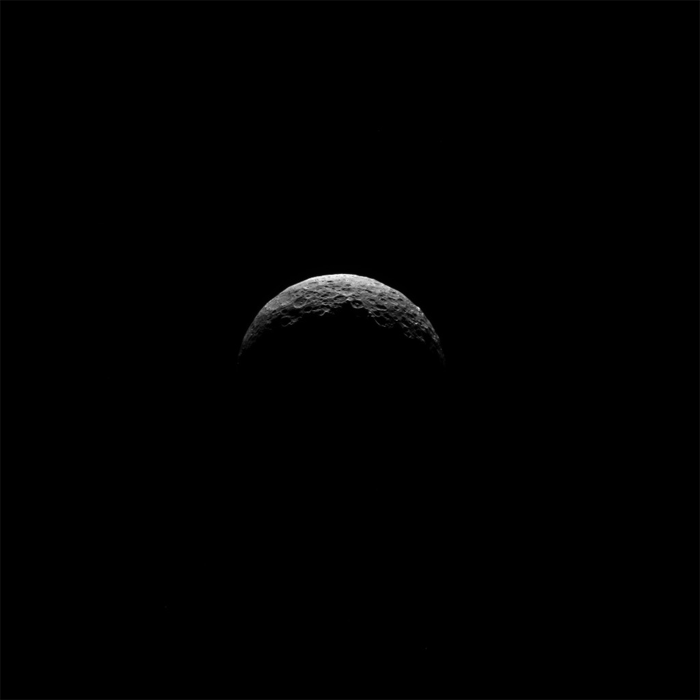
This animation shows the north pole of dwarf planet Ceres as seen by the Dawn spacecraft on April 10, 2015. Dawn was at a distance of 21,000 miles (33,000 kilometers) when its framing camera took these images.
Image Credit: NASA/JPL-Caltech/UCLA/MPS/DLR/IDA
.
After spending more than a month in orbit on the dark side of dwarf planet Ceres, NASA's Dawn spacecraft has captured several views of the sunlit north pole of this intriguing world. These images were taken on April 10 from a distance of 21,000 miles (33,000 kilometers), and they represent the highest-resolution views of Ceres to date.
Subsequent images of Ceres will show surface features at increasingly better resolution.
Dawn arrived at Ceres on March 6, marking the first time a spacecraft has orbited a dwarf planet. Previously, the spacecraft explored giant asteroid Vesta for 14 months from 2011 to 2012. Dawn has the distinction of being the only spacecraft to orbit two extraterrestrial targets.
Ceres, with an average diameter of about 590 miles (950 kilometers), is the largest body in the main asteroid belt between Mars and Jupiter. Dawn has been using its ion propulsion system to maneuver to its first science orbit at Ceres, which it will reach on April 23. The spacecraft will remain at a distance of 8,400 miles (13,500 kilometers) from the dwarf planet until May 9. Afterward, it will make its way to lower orbits.
Dawn's mission is managed by NASA's Jet Propulsion Laboratory, Pasadena, California, for NASA's Science Mission Directorate in Washington. Dawn is a project of the directorate's Discovery Program, managed by NASA's Marshall Space Flight Center in Huntsville, Alabama. UCLA is responsible for overall Dawn mission science. Orbital ATK, Inc., in Dulles, Virginia, designed and built the spacecraft. The German Aerospace Center, the Max Planck Institute for Solar System Research, the Italian Space Agency and the Italian National Astrophysical Institute are international partners on the mission team.
Quelle: NASA
.
Update: 21.04.2015
.
NASA Snaps New Views of Dwarf Planet Ceres' Mystery Spots (Video)
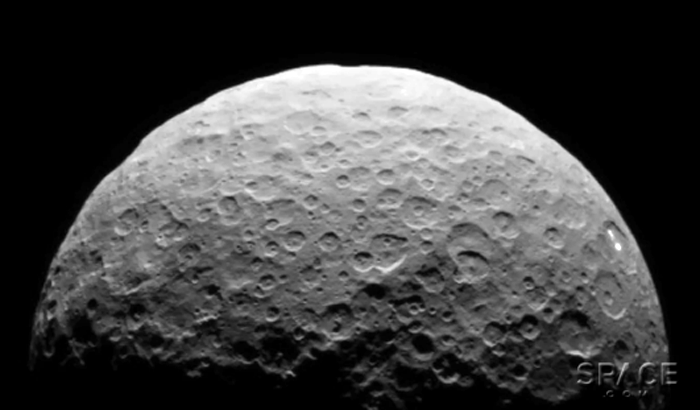
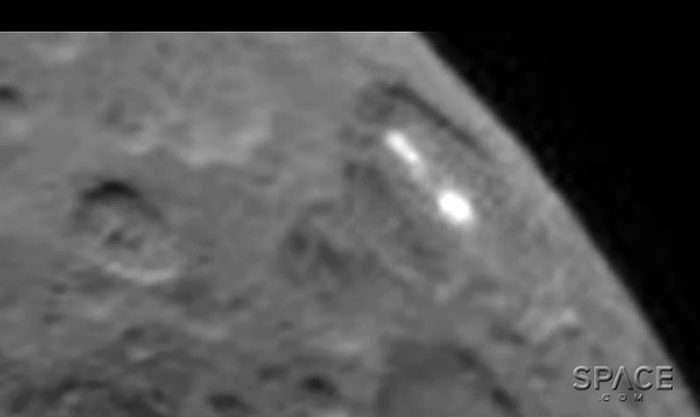
NASA's Dawn spacecraft has photographed Ceres' intriguing bright spots again as it prepares to begin its science mission at the dwarf planet.
Dawn, which arrived at Ceres on March 6, imaged the mysterious bright spots on April 14 and 15 during a photography campaign designed to help guide the spacecraft to its first Ceres science orbit by April 23. NASA officials combined the photos into a short video that shows Ceres' bright spots moving as the dwarf planet rotates.
"The approach imaging campaign has completed successfully by giving us a preliminary, tantalizing view of the world Dawn is about to start exploring in detail," Dawn Mission Director and Chief Engineer Marc Rayman, of NASA's Jet Propulsion Laboratory in Pasadena, California, said in a statement. "It has allowed us to start asking some new and intriguing questions."
The new photos were taken when Dawn was about 14,000 miles (22,500 kilometers) above Ceres' north pole, NASA officials said. It's still unclear what, exactly, the white spots are. (Scientists suspect they're deposits of either water ice or salts.)
The bright spots' makeup is just one of many mysteries Dawn will explore with the beginning of intensive observations on April 23. Those initial observations will be made from a circular orbit about 8,400 miles (13,500 km) above the dwarf planet's surface. Then, on May 9, Dawn will begin spiraling closer, to get even better views of Ceres, which, at 590 miles (950 km) wide, is the largest denizen of the main asteroid belt between Mars and Jupiter.
.
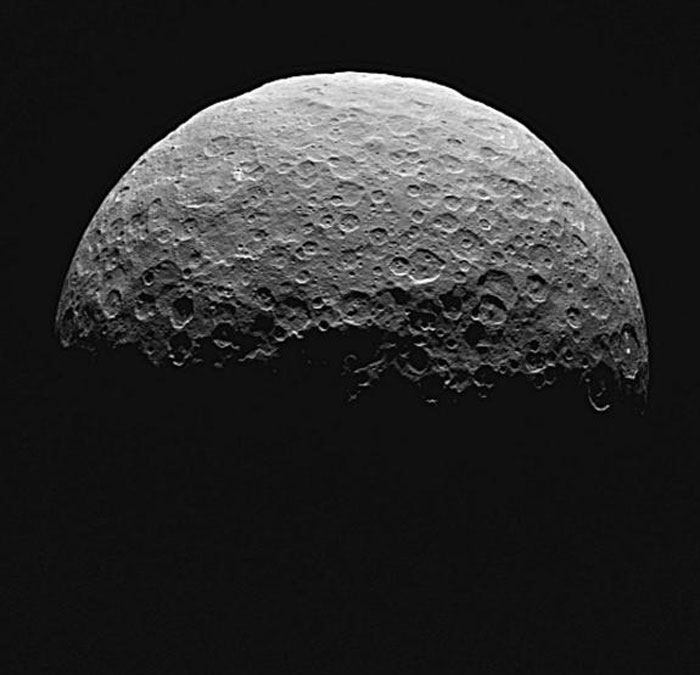
NASA's Dawn spacecraft captured this image of northern Ceres on April 14 and 15, 2015, when it was about 14,000 miles (22,500 kilometers) above the dwarf planet's north pole.
Credit: NASA/JPL-Caltech/UCLA/MPS/DLR/IDA
.
The $466 million Dawn mission launched in September 2007 to study Ceres and Vesta, the asteroid belt's second-biggest body. Both objects are intact protoplanets left over from the solar system's early days; investigating them should reveal key insights about how rocky planets such as Earth came to be, mission officials have said.
Dawn orbited Vesta from July 2011 to September 2012, when the probe departed for Ceres. Dawn is scheduled to keep observing the dwarf planet until June 2016, when it will run out of fuel.
Dawn is the only spacecraft ever to orbit two different bodies beyond the Earth-moon system, and the first probe to study a dwarf planet up close. Another NASA probe is about to get a good look at the solar system's most famous dwarf planet: the New Horizons spacecraft will zoom past Pluto on July 14, lifting the veil on a body that has remained mysterious since its 1930 discovery.
.
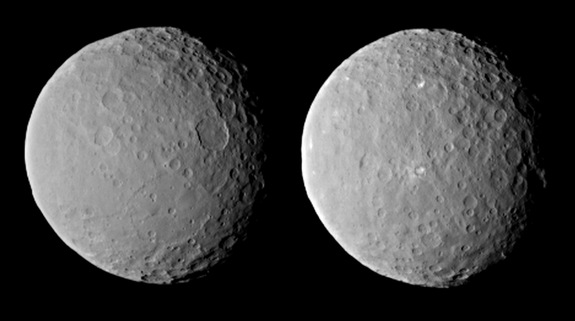
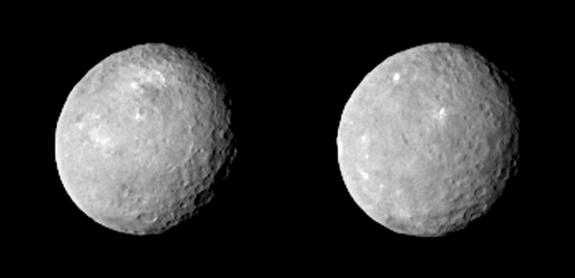
Quelle: SC
.
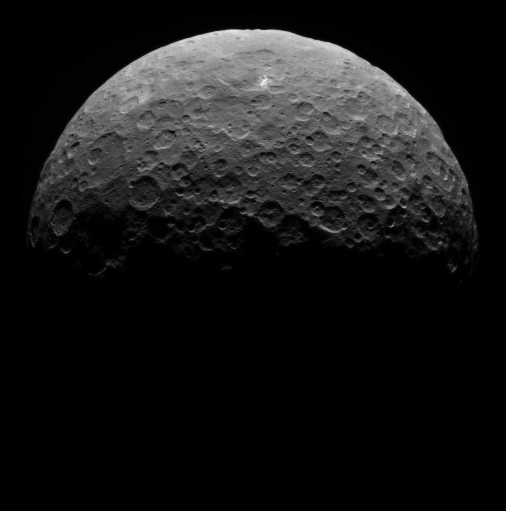
Quelle: NASA
-
Update: 22.04.2015
.
Ceres North Pole View
Several intriguing and as yet unexplained bright spots also dot the surface.
“There is no analog to this visual phenomena in the solar system,” Russell told AmericaSpace.
“When we understand it better we may find an analog that displays itself differently. But this is a total surprise. Right now it seems to be unique!”
.
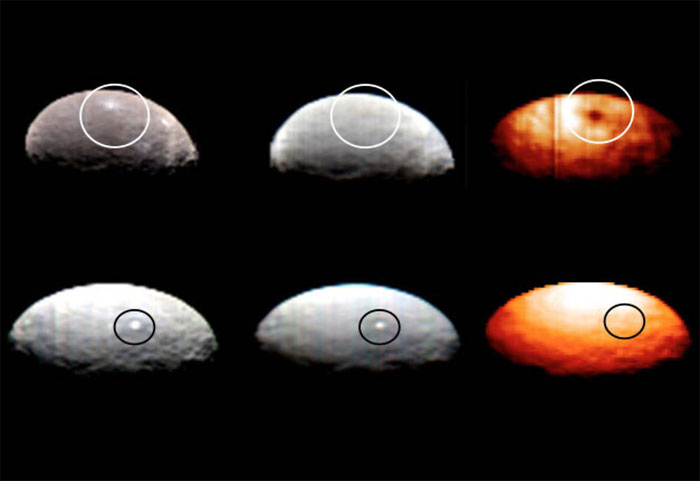
These images, from Dawn’s visible and infrared mapping spectrometer (VIR), highlight two regions on Ceres containing bright spots. The top images show a region scientists have labeled “1” and the bottom images show the region labeled “5.” Region 5 contains the brightest spots on Ceres. Credits: NASA/JPL-Caltech/UCLA/ASI/INAF
.
Dawn made history in March when it simultaneously became the first probe from Earth to reach Ceres as well as the first spacecraft to orbit two extraterrestrial bodies.
It had previously visited Vesta. After achieving orbit in July 2011, Dawn became the first spacecraft from Earth to orbit a body in the main Asteroid Belt, located between Mars and Jupiter.
The probe remained in orbit around the rocky world for an extended mission of 14 months, yielding reams of bonus science images and spectral data for the research teams until departing in September 2012. Vesta is a dry world.
After an interplanetary voyage of some two and a half years and achieving orbit, the ship flew on its planned trajectory on the dark side of Ceres — the side facing away from the sun. It reached a maximum altitude of 46,800 miles (75,400 kilometers) on March 18 based on the spacecraft’s momentum.
Dawn is descending toward the first planned science orbit, which will be 8,400 miles (13,500 kilometers) above the surface. After it arrives on April 23, the spacecraft starts the first “intensive prime science campaign” says NASA.
The first images from the dark side are crescent views taken on April 10 and April 14.
The north pole of Ceres was glimpsed on April 10 in its highest resolution yet. The view is shown herein and taken from a distance of 21,000 miles (33,000 kilometers).
The solar powered probe was approximately 38,000 miles (61,000) kilometers distant at the moment it slipped into orbit around Ceres on March 6.
In sharp contrast to Vesta, Ceres is an icy world.
Scientists believe that Ceres may harbor an ocean of subsurface liquid water as large in volume as the oceans of Earth below a thick icy mantle despite its small size – and thus could be a potential abode for life. Overall Ceres is estimated to be about 25% water by mass.
Dawn’s images obtained thus far reveal Ceres to be a pockmarked world with craters of many sizes, large and small.
Ceres is a huge and mysterious alien world the size of Texas. It measures approximately 590 miles (950 kilometers) in diameter and is nearly round.
It is the largest and most massive object in the main Asteroid Belt, which lies between Mars and Jupiter. Vesta is the second most massive object in the asteroid belt.
Both are fossil remnants dating back to the formation of our Solar System. Exploring the difference between the two will help elucidate our understanding of the origin and evolution of our solar system.
Today, Ceres features a remarkable collection of perhaps 10 or more bright spots. The brightest are a duo of dauntingly mysterious bright spots smack dab in the middle of a 57 miles (92 kilometers) wide crater that look like a pair “eyes.”
The bright spots have not yet been resolved in the camera images. They will be resolved soon, now that Dawn is spiraling down in altitude ever closer towards the surface.
“More detail will emerge after the spacecraft begins its first intensive science phase on April 23,” said Martin Hoffmann, investigator on the Dawn framing camera team, based at the Max Planck Institute for Solar System Research, Göttingen, Germany.
The bright spots are reflected sunlight, but what these reflections represent and the nature of their composition is still unknown.
“The bright spots continue to fascinate the science team, but we will have to wait until we get closer and are able to resolve them before we can determine their source,” Russell noted.
.
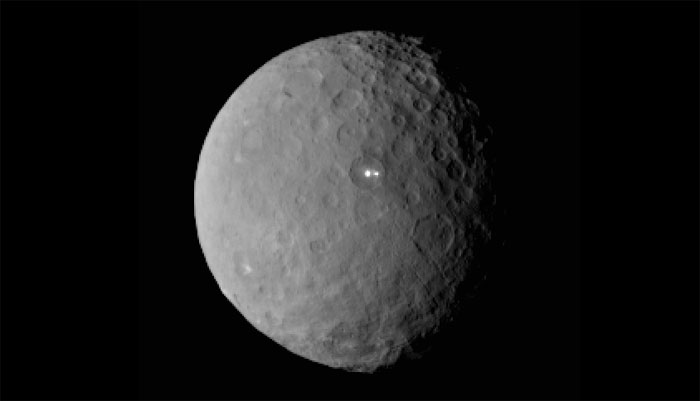
2 Brightest spots on Ceres. This image was taken by NASA’s Dawn spacecraft of dwarf planet Ceres on Feb. 19 from a distance of nearly 29,000 miles (46,000 kilometers). It shows that the brightest spot on Ceres has a dimmer companion, which apparently lies in the same basin. Credit: NASA/JPL-Caltech/UCLA/MPS/DLR/IDA
.
Dawn is an international science mission run by NASA and equipped with a trio of science instruments from the US, Germany and Italy.
The visible and infrared mapping spectrometer (VIR), provided by Italy is an imaging spectrometer that examines Ceres in visible and infrared light.
The team is using it to determine the temperatures of Ceres surface features, says Federico Tosi, investigator from the VIR instrument team at the Institute for Space Astrophysics and Planetology, and the Italian National Institute for Astrophysics, Rome.
Curiously, the various bright regions on Ceres appear to exhibit different temperature profiles, deepening their mysterious nature. Some spots, including the bright pair, have temperatures similar to their surroundings. Whereas others are cooler by comparison.
Dawn was launched on September 27, 2007 by a United Launch Alliance (ULA) Delta II Heavy rocket from Space Launch Complex-17B (SLC-17B) at Cape Canaveral Air Force Station, Florida.
Stay tuned here for continuing updates on Dawns’ orbital capture and science mission at protoplanet Ceres!
Quelle: AS
4787 Views
